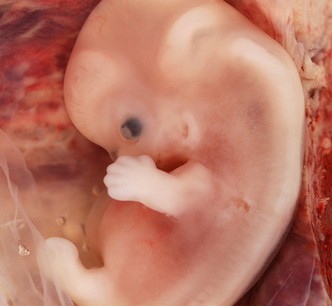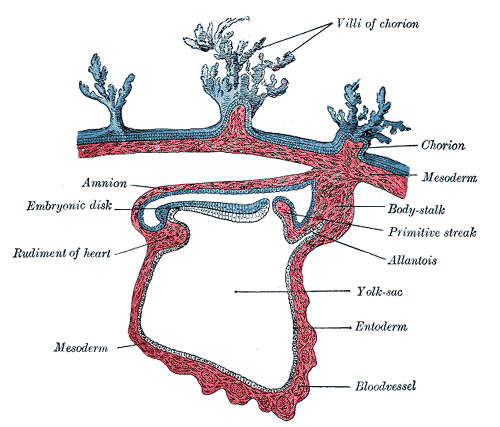THE URINARY SYSTEM
 THE KIDNEYS, which excrete urine
THE KIDNEYS, which excrete urine THE URETERS, which convey urine from the kidneys to the urinary bladder
THE URETERS, which convey urine from the kidneys to the urinary bladder THE URINARY BLADDER, which stores urine temporarily
THE URINARY BLADDER, which stores urine temporarily THE URETHRA, which carries urine from the bladder to the exterior of the body
THE URETHRA, which carries urine from the bladder to the exterior of the bodyDEVELOPMENT OF URINARY SYSTEM
Urinary system develops before the genital system.
Both systems develop from intermediate mesoderm
Three overlapping kidney system forms in succession in cranial to caudal sequence.
PHYLOGENETIC STAGES OF OVERLAPPING EXCRETORY ORGANS
•Pronephros, a structure similar to that found in primitive vertebrates (fish).
•Mesonephros, a more advanced system found in amphibia.
•Metanephros which elaborates into the final human form.
PRONEPHROS(EARLY 4th WEEK)
 Rudimentary, transitory and non functional
Rudimentary, transitory and non functional
 Represented by 7 to 10 solid cell groups in cervical region
Represented by 7 to 10 solid cell groups in cervical region
 Forms vestigial excretory units, nephrotomes
Forms vestigial excretory units, nephrotomes
 No glomeruli
No glomeruli
 No connection b/w pronephric duct and excretory tubules
No connection b/w pronephric duct and excretory tubules
 Cranial regress before more caudal ones are formed
Cranial regress before more caudal ones are formed
 End of 4 wks – Disappears
MESONEPHROS/ INTERIM KIDNEYS FUNCTION FOR 4 WKS (upper thoracic to upper Lumber L3 segments )
End of 4 wks – Disappears
MESONEPHROS/ INTERIM KIDNEYS FUNCTION FOR 4 WKS (upper thoracic to upper Lumber L3 segments )
 Formation of glomerulus and S- shaped excretory tubules (Increase in length causes it to bend)
Formation of glomerulus and S- shaped excretory tubules (Increase in length causes it to bend)
 Formation of Bowman’s capsule
Formation of Bowman’s capsule
 Tubules enter into mesonephric/ Wolffian duct, a continuation of the pronephric duct
Tubules enter into mesonephric/ Wolffian duct, a continuation of the pronephric duct
 Function for a short time for about 4 weeks
Function for a short time for about 4 weeks
 IN THE MIDDLE OF SECOND MONTH
IN THE MIDDLE OF SECOND MONTH
 Formation of urogenital ridge
Formation of urogenital ridge
 While caudal tubules are differentiating, cranial tubules & glomeruli show degenerative changes
While caudal tubules are differentiating, cranial tubules & glomeruli show degenerative changes
 BY THE END OF SECOND MONTH:
BY THE END OF SECOND MONTH:
 Mesonephric ducts open into cloaca & persist in males as epididymis, vasdeferens, ejaculatory ducts,seminal vesicles
Mesonephric ducts open into cloaca & persist in males as epididymis, vasdeferens, ejaculatory ducts,seminal vesicles
 Few caudal tubules persist – Efferent ductules of testes
Few caudal tubules persist – Efferent ductules of testes
METANEPHROS/
DEFINITIVE KIDNEY
 Appears in 5th wk, lies in pelvic region
Appears in 5th wk, lies in pelvic region
 Permanent kidney develops from two sources:
Permanent kidney develops from two sources:
 Metanephric diverticulum / Ureteric bud
Metanephric diverticulum / Ureteric bud
 Metanephric blastema (mass of unsegmented mesoderm)
Metanephric blastema (mass of unsegmented mesoderm)
REASONS FOR THE ASCEND OF KIDNEYS
1.Dimunition of body curvature
2.Growth of the body in lumber & sacral regions
Arterial supply changes as it ascends
RECIPROCAL INDUCTION TO FORM PERMANENT KIDNEYS
•The ureteric bud is essential for induction & differentiation in the metanephric mesoderm.
•The metanephric cap is essential for bifurcation of the ureteric bud.
•The collecting ducts are essential for differentiation of the nephrons.
 Metanephric diverticulum
is the primodium of:
•Ureters
•Renal pelvis
•Calyces
•Collecting tubules
Metanephric diverticulum
is the primodium of:
•Ureters
•Renal pelvis
•Calyces
•Collecting tubules
 Metanephric blastema
is the primodium of:
Nephrons
Metanephric blastema
is the primodium of:
Nephrons
FUNCTION OF THE KIDNEY
•Becomes functional by 12th week
•During fetal life kidneys are NOT responsible for excretion of waste products
WILM’S TUMOR / NEPHROBLASTOMA
•Cancer of kidneys usually unilateral affects children by 5 years of age
•Due to mutation in genes
•Encapsulated & vascularised
RENAL DYSPLASIAS & AGENESIS
may arise if the interaction between the metanephric mesoderm and the ureteric bud fails to occur.
•Cause:
Genes Mutations
•Potters sequence: Anuria, oligohydroamnios & hypoplastic lungs
AUTOSOMAL RECESSIVE POLYCYSTIC KIDNEY DISEASE
 Occurs in 1/5,000 births
Occurs in 1/5,000 births
 A progressive disorder in which cysts form from collecting ducts.
A progressive disorder in which cysts form from collecting ducts.
 The kidneys become very large, and renal failure occurs in infancy or childhood
The kidneys become very large, and renal failure occurs in infancy or childhood
PHYLOGENETIC STAGES OF OVERLAPPING EXCRETORY ORGANS
•Pronephros, a structure similar to that found in primitive vertebrates (fish).
•Mesonephros, a more advanced system found in amphibia.
•Metanephros which elaborates into the final human form.
PRONEPHROS(EARLY 4th WEEK)
 Rudimentary, transitory and non functional
Rudimentary, transitory and non functional  Represented by 7 to 10 solid cell groups in cervical region
Represented by 7 to 10 solid cell groups in cervical region  Forms vestigial excretory units, nephrotomes
Forms vestigial excretory units, nephrotomes  No glomeruli
No glomeruli  No connection b/w pronephric duct and excretory tubules
No connection b/w pronephric duct and excretory tubules Cranial regress before more caudal ones are formed
Cranial regress before more caudal ones are formed End of 4 wks – Disappears
End of 4 wks – Disappears MESONEPHROS/ INTERIM KIDNEYS FUNCTION FOR 4 WKS (upper thoracic to upper Lumber L3 segments )
 Formation of glomerulus and S- shaped excretory tubules (Increase in length causes it to bend)
Formation of glomerulus and S- shaped excretory tubules (Increase in length causes it to bend)  Formation of Bowman’s capsule
Formation of Bowman’s capsule  Tubules enter into mesonephric/ Wolffian duct, a continuation of the pronephric duct
Tubules enter into mesonephric/ Wolffian duct, a continuation of the pronephric duct Function for a short time for about 4 weeks
Function for a short time for about 4 weeks IN THE MIDDLE OF SECOND MONTH
IN THE MIDDLE OF SECOND MONTH  Formation of urogenital ridge
Formation of urogenital ridge While caudal tubules are differentiating, cranial tubules & glomeruli show degenerative changes
While caudal tubules are differentiating, cranial tubules & glomeruli show degenerative changes BY THE END OF SECOND MONTH:
BY THE END OF SECOND MONTH: Mesonephric ducts open into cloaca & persist in males as epididymis, vasdeferens, ejaculatory ducts,seminal vesicles
Mesonephric ducts open into cloaca & persist in males as epididymis, vasdeferens, ejaculatory ducts,seminal vesicles Few caudal tubules persist – Efferent ductules of testes
Few caudal tubules persist – Efferent ductules of testesMETANEPHROS/
DEFINITIVE KIDNEY
 Appears in 5th wk, lies in pelvic region
Appears in 5th wk, lies in pelvic region Permanent kidney develops from two sources:
Permanent kidney develops from two sources: Metanephric diverticulum / Ureteric bud
Metanephric diverticulum / Ureteric bud  Metanephric blastema (mass of unsegmented mesoderm)
Metanephric blastema (mass of unsegmented mesoderm)REASONS FOR THE ASCEND OF KIDNEYS
1.Dimunition of body curvature
2.Growth of the body in lumber & sacral regions
Arterial supply changes as it ascends
RECIPROCAL INDUCTION TO FORM PERMANENT KIDNEYS
•The ureteric bud is essential for induction & differentiation in the metanephric mesoderm.
•The metanephric cap is essential for bifurcation of the ureteric bud.
•The collecting ducts are essential for differentiation of the nephrons.
 Metanephric diverticulum
Metanephric diverticulum is the primodium of:
•Ureters
•Renal pelvis
•Calyces
•Collecting tubules
 Metanephric blastema
Metanephric blastema is the primodium of:
Nephrons
FUNCTION OF THE KIDNEY
•Becomes functional by 12th week
•During fetal life kidneys are NOT responsible for excretion of waste products
WILM’S TUMOR / NEPHROBLASTOMA
•Cancer of kidneys usually unilateral affects children by 5 years of age
•Due to mutation in genes
•Encapsulated & vascularised
RENAL DYSPLASIAS & AGENESIS
may arise if the interaction between the metanephric mesoderm and the ureteric bud fails to occur.
•Cause:
Genes Mutations
•Potters sequence: Anuria, oligohydroamnios & hypoplastic lungs
AUTOSOMAL RECESSIVE POLYCYSTIC KIDNEY DISEASE
 Occurs in 1/5,000 births
Occurs in 1/5,000 births A progressive disorder in which cysts form from collecting ducts.
A progressive disorder in which cysts form from collecting ducts.  The kidneys become very large, and renal failure occurs in infancy or childhood
The kidneys become very large, and renal failure occurs in infancy or childhood AUTOSOMAL DOMINANT POLYCYSTIC KIDNEY DISEASE
 Cysts form from all segments of the nephron and usually do not cause renal failure until adulthood.
Cysts form from all segments of the nephron and usually do not cause renal failure until adulthood. More common (1/500 or 1/1,000 births) but less progressive than the autosomal recessive disease
More common (1/500 or 1/1,000 births) but less progressive than the autosomal recessive diseaseDUPLICATION OF THE URETER
 Results from early splitting of ureteric bud
Results from early splitting of ureteric bud  Complete or Partial
Complete or PartialABNORMAL LOCATION OF THE KIDNEY
 Pelvic kidney-— if fails to pass through arterial fork formed by umbilical arteries.
Pelvic kidney-— if fails to pass through arterial fork formed by umbilical arteries. Horse shoe kidney-— pushed close during passage; lower lumbar vertebra; ascent prevented by root of Inferior Mesentric Artery
Horse shoe kidney-— pushed close during passage; lower lumbar vertebra; ascent prevented by root of Inferior Mesentric ArteryDEVELOPMENT OF URINARY BLADDER
 During 4th to 7th week of development, the cloaca divides into urogenital sinus anteriorly & the anal canal posteriorly
During 4th to 7th week of development, the cloaca divides into urogenital sinus anteriorly & the anal canal posteriorly Urorectal septum – Formation of perineal body
Urorectal septum – Formation of perineal body Three portions of urogenital sinus:
Three portions of urogenital sinus:  Upper, largest part is Vesical part: Urinary bladder
Upper, largest part is Vesical part: Urinary bladder  Pelvic part: Prostatic and membranous part of urethra
Pelvic part: Prostatic and membranous part of urethra  Phallic part : Penile urethra
Phallic part : Penile urethra  During differentiation of cloaca, the caudal portions of mesonephric ducts are absorbed into the wall of urinary bladder
During differentiation of cloaca, the caudal portions of mesonephric ducts are absorbed into the wall of urinary bladder  Mucosa of trigone initially mesodermal & later endodermal
Mucosa of trigone initially mesodermal & later endodermal DEVELOPMENT OF URETHRA
 Origin of epithelium — endoderm
Origin of epithelium — endoderm Surrounding C.T. and smooth muscle — splanchnic mesoderm
Surrounding C.T. and smooth muscle — splanchnic mesoderm At the end of 3rd month, epithelium of prostatic urethra begins to proliferate and forms a number of outgrowths that penetrate the surrounding mesenchyme
At the end of 3rd month, epithelium of prostatic urethra begins to proliferate and forms a number of outgrowths that penetrate the surrounding mesenchyme In the male, these buds form the PROSTATE GLAND
In the male, these buds form the PROSTATE GLAND  In the female, the cranial part of urethra gives rise to the URETHRAL AND PARAURETHRAL GLANDS
In the female, the cranial part of urethra gives rise to the URETHRAL AND PARAURETHRAL GLANDS BLADDER DEFECTS
 URACHAL FISTULA
URACHAL FISTULA  URACHAL CYST
URACHAL CYST  URACHAL SINUS
URACHAL SINUSEXSTPROPHY OF BLADDER
 Ventral body wall defect, bladder mucosa is exposed
Ventral body wall defect, bladder mucosa is exposed  Epispadias is a constant feature
Epispadias is a constant feature  Caused by lack of mesodermal migration into the region between umbilicus and genital tubercle followed by rupture of thin layer of ectoderm
Caused by lack of mesodermal migration into the region between umbilicus and genital tubercle followed by rupture of thin layer of ectoderm  This anomaly is rare, occurring in 2/100000 live births
This anomaly is rare, occurring in 2/100000 live births
 howMed Know Yourself
howMed Know Yourself



